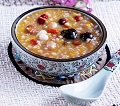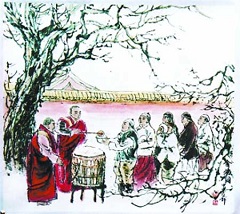|
Chinese Laba Festival

The 8th day of the 12th lunar month is the Laba Festival (Chinese: 腊八节, 臘八節).
The 12th lunar month is the last of month of the year and time for sending out the old year and preparing for the new year.
So ancient Chinese people performs large ceremonies to report to their ancestors of their harvest of the past year.
The Chinese Laba Festival falls on the following dates in the Gregorian calendar:
| Year 2011 | Sunday | January 1, 2012 | Chinese Laba Festival |
| Year 2012 | Saturday | January 19, 2013 | Chinese Laba Festival |
| Year 2013 | Wednesday | January 8, 2014 | Chinese Laba Festival |
| Year 2014 | Tuesday | January 27, 2015 | Chinese Laba Festival |
| Year 2015 | Sunday | January 17, 2016 | Chinese Laba Festival |
| Year 2016 | Thursday | January 5, 2017 | Chinese Laba Festival |
| Year 2017 | Wednesday | January 24, 2018 | Chinese Laba Festival |
| Year 2018 | Sunday | January 13, 2019 | Chinese Laba Festival |
| Year 2019 | Thursday | January 2, 2020 | Chinese Laba Festival |
| Year 2020 | Wednesday | January 20, 2021 | Chinese Laba Festival |
Origin
 Before the Qin Dynasty, Laba festival was a celebration of the harvest of the past at the end of calendar year
with large ceremonies to worship ancestor.
Before the Qin Dynasty, Laba festival was a celebration of the harvest of the past at the end of calendar year
with large ceremonies to worship ancestor.
After Buddhism spread to China during the first century AD,
the Laba festival was also used as commemoration of Shakyamuni Buddha's enlightenment at the age of 35
on the same date, eighth of 12th lunar month (腊月八日).
Activities
The most important activaty on the Laba Festival is to eat Laba congee, or porridge, (腊八粥)
which is made of mixed rice, beans, dried fruit, tofu, potato, meat and vegetables.
Sometimes the congee is decorated with coloured sweets or dried fruits.
Buddhist temples held dharma assemblies and chanted prayers in honor of Shakyamuni Buddha
to mark the day of Buddha’s Enlightenment.
Buddhist temples also prepare Laba porridge and offer it to the devotees and visitors on that day.
 Another Laba food is Laba garlic (腊八蒜), which is a vinegar-preserved garlic.
Its refined color is green and its taste is sour and slightly spicy.
Laba garlic is particularly popular in northern China.
Another Laba food is Laba garlic (腊八蒜), which is a vinegar-preserved garlic.
Its refined color is green and its taste is sour and slightly spicy.
Laba garlic is particularly popular in northern China.
Other traditional activities on the Laba Festival include worshiping ancestors and gods.
|